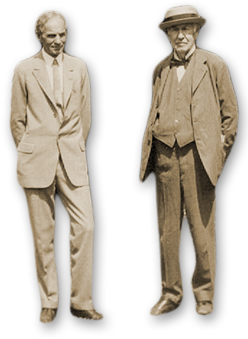The Flamboyant Tree
June 20, 2023
By Karen Maxwell, Horticultural Specialist
In June, nature opens her jewel box in Southwest Florida. Among the extraordinary collection of flowering shrubs, orchids and perennials, the flowering trees are the showstoppers. Space does not permit me to discuss all of them in this article, but certainly watch for the Jacaranda (Jacaranda mimosifolia), Golden Shower (Cassia fistula), and Yellow Poinciana (Peltophorum pterocarpum) during your early summer stroll around the Estates.
No, I didn’t miss one – Delonix regia, the Royal Poinciana or Flame Tree is perhaps the most celebrated of this elite collection and it has a special place in Florida’s art history. The oldest festival in Miami is the Poinciana Fiesta in proximity to where the oldest Royal Poinciana, located at the Kampong in Coral Gables, was planted by Mrs. David Fairchild in 1917. Closer to home, the Royal Poinciana was documented on our property as far back as the 1880s, but how it came to be on our site, I cannot determine. Over the years, I have enjoyed photographing the many we have had at the Estates – in the parking lot, along the river, on the Ford property, and in Edison’s research gardens. Several were destroyed or badly damaged last September.
Prior to Hurricane Ian, a pair of Royal Poincianas planted by the City of Fort Myers in 1947 created a flaming arch for visitors as they departed the property at the Marlyn Road exit. Native to Madagascar, those of us who are fortunate to reside here in USDA growing zone 10a-10b enjoy the northern range of these tropical trees. They are easily grown from seed extracted from the long, hard brown seed pods, but young plants cannot tolerate temperatures below 50 degrees. Once mature, these drought-tolerant beauties can withstand short temperature dips; however, most of our Royal Poincianas are deciduous due to cooler temperatures during the winter months. In warmer tropical areas, where temperatures rarely drop below 60 degrees, they are evergreen.
Like giant, red umbrellas, one cannot miss a Royal Poinciana in bloom. Generally red, their color ranges from a true yellow through orange to fire red (Arbol de fuego in Spanish speaking countries). The brilliance of the flowers is complemented by a backdrop of complex bi-pinnate leaflets of bright green which fold up at dusk. The Yellow “Poinciana” is not a Delonix regia, but rather a Peltophorum pterocarpum, so we call it a Copperpod to avoid confusion.
The Royal Poincianas of all colors, are distinguished by their unique five-petal flowers, with one petal always significantly larger than the remaining four; it is theorized that this is nature’s design to attract butterfly pollinators. The claw-like shape of the petal gives rise to its botanical name Delonix regia after the Greek “delos” meaning visible and “onyx” meaning claw and the Latin “regia” meaning royal or magnificent. This larger petal is called a standard or a banner. Like all plants in the Legume Family, the Royal Poinciana is useful in soil restoration due to its capacity to convert air-born nitrogen (such as from lightening) to a soil-sourced nitrogen for growth.
The easily distinguished shape of the Royal Poinciana makes it an excellent candidate for Bonsai enthusiasts – the short but large main trunk quickly articulates into heaving branching, creating a tree wider than it is tall. This structure accounts for its vulnerability during heavy wind events and the reaching, extensive, sometimes buttress- like roots can wreak havoc with sidewalks and driveways.
When I picture a Royal Poinciana, I cannot help but imagine some of the landscape artworks created by the Florida Highwaymen – a group of itinerant African American artists based out of the Indian River area and so named in the 1990s by a Florida museum curator, Jim Fitch. Their artwork was primarily of native Florida landscapes that featured cabbage palms and cypress domes, often with sunsets along the river to provide a dramatic focal point in an otherwise heavy canopy of plantings. Reading the history of the Highwaymen is encouraged as I will just be scratching the surface of their legacy here to relate their story to the Royal Poinciana.
During the 1950s through to the 1980s, it is believed that about 200,000 pieces were sold; the original and so-called most valuable pieces were created on Upson (a roofing product) or Masonite and only those are considered by experts as works of the original highwaymen genre. Among the most easily recognized Florida Highwaymen pieces of art, are those that include a Royal Poinciana and the most desired images were created by one of the original six artists – and she was the only woman in the group of 26 inducted into the Florida Hall of Fame in 2004. Because they were not allowed into white art galleries, this mother of seven, an accomplished painter and musician, joined with the other five and took to the road to sell their art door-to-door, thereby providing an income above that of sharecroppers. Mary Ann Carroll* passed away on December 4, 2019 and her work is now among the most highly sought after of the Florida Highwaymen.
“And only the highway woman
Keeps up with the likes of those
And she in all her magic
With hands as quick as light” – Stevie Nicks
If you wish to learn more, I recommend a series of books written by Gary Munroe, including “Mary Ann Carroll, First
Lady of the Highwaymen.” In 2011, Ms. Carroll presented the First Lady, Michelle Obama, with a painting of her favorite subject, the Royal Poinciana.
*Not to be confused with Maryanna Carroll who was a longtime horticulturist/caretaker at Edison and Ford Winter Estates.
Garden BOLO (be on the lookout): During the summer months, the best time to visit is when we open at 9 a.m. Bring your camera and take lots of photos – and I hope you’ll share them with me at kmaxwell@edisonford.org.
Photos: Courtesy of K.M. Maxwell




